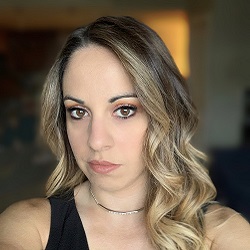10 Stunning Lowlights Ideas for Rich Dimensional Colors
I’m sure you’ve heard the term lowlights used before, but what are they and what is their function? To get lowlights, your stylist will add in a color that is several shades darker than your base color using a foil highlight technique or even a balayage. Thus, lowlights and highlights are achieved using the same techniques, the difference being in whether the colored strands are darker or lighter than the base color.
Blending lowlights and highlights creates contrast and dimension resulting in some gorgeous color transformation. Read on for the comprehensive lowlights vs highlights guide and the best examples of how to enhance your hair color with lowlights.
When Hair with Lowlights Is a Good Idea
There are different reasons you would want to get hair lowlights. Sometimes, you are just looking to add dimension to your highlighted hair. In this case, adding a darker color will make the lighter highlights show up more. This is very common with the modern dimensional color that is so popular today.
Look at this example of blonde hair without lowlights. It is more solid-looking and has less dimension in it.

Instagram / @sarahzstylz
Now, watch how it comes to life with lowlights. The dark shade next to the lighter ones makes them brighter.

Instagram / @sarahzstylz
Another case when a colorist would advise getting hair lowlights is to fix hair color after summer when your hair is really light or brassy from the sun. Lowlights can help you eliminate some of the brass and get a nice natural look for your mane.
Also, women who are frequent blonding clients and have had consecutive highlights put in might need to get back to the dimension they had when they first started. If this is your case, adding lowlights can bring some of your natural hair color back.
When styling lowlights, you want to add waves or curls to your hair – this will make them show up better. If you wear your hair straight, highlights and lowlights won’t show up as much.
See the best looks with highlights and lowlights you might want to copy!
1. Brown Hair with Highlights and Lowlights
Balayage is meant to be natural-looking, as if your hair lightens in the sun during summertime, so adding lowlights will help give it dimension. This look is a traditional brown hair balayage with highlights and lowlights added in.

Instagram / @sarahzstylz
2. Brown Lowlights
Brunettes should leave dimension for a more natural grow-out, so lowlights help keep it natural. This technique is called foilayage, and it’s used to mimic a balayage using traditional lightener with teasing to accomplish this lighter blonde. I add lowlights to make the blonde pop and keep it dimensional.

Instagram / @sarahzstylz
3. Caramel Lowlights
Caramel lowlights are a great option for the fall hair color. This technique is a mix of highlights and lowlights. You can add a warm brown lowlight and tone down your highlights for the fall/winter to create this beautiful caramel look.

Instagram / @sarahzstylz
4. Icy Blonde Highlights with Lowlights
Blondes should add lowlights to make blonde strands pop more! This technique is also called a foilayage. This client is a natural brunette, so it may take several sessions to go this light. If you are a natural brunette and you want to be really blonde, adding lowlights and root shadowing will help achieve depth and make the color more low-maintenance.

Instagram / @sarahzstylz
5. Natural Redhead with Brighter Red Lowlights
Enhancing a natural redhead with highlights and lowlights will really make their hair stand out. This client has a beautiful natural auburn color, but sometimes it can lack dimension. Adding brighter red lowlights along with golden blonde highlights will really make it intricate and rich.

Instagram / @sarahzstylz
6. Burgundy Lowlights with Copper Highlights
Burgundy and copper tones are great for fall! Adding two hair colors will really bring brown hair to life. This client is already a natural brunette but we added these beautiful warm tones using highlights and lowlights to enhance her natural olive skin color.

Instagram / @sarahzstylz
7. Lowlights to Add Depth to Blonde Hair
Leaving depth underneath your blonde hair is important to make blonde highlights on top stand out. For natural blondes that want to go lighter, the word “lowlight” might sound scary. Still, adding this depth in will actually make your blonde hair look lighter! So don’t be afraid!

Instagram / @sarahzstylz
8. Ash Lowlights for Cool Hair Color
Adding a darker ash tone next to an icy blonde will keep a brunette looking cooler. It’s important when you ask your colorist to add dimension and maintain a cooler all-over look, eliminating as much warmth as possible. Adding both cool-toned highlights and brown lowlights will help achieve this.

Instagram / @sarahzstylz
9. High Contrast Face-Framing Highlights
I’m sure you heard the term money piece by now, that is a heavy highlight that you see in everyone’s hairline. As a stylist, one of the most important areas that I place a lowlight is right behind the face frame. This gives you that bold pop of blonde right in the front.

Instagram / @sarahzstylz
10. Lowlights for Gray Hair
Another way to use lowlights is for gray blending. A way to camouflage gray is adding cool toned highlights and a lowlight that is close to your natural color. This look requires frequent toning sessions. You can also use purple shampoo at home for maintenance.

Instagram / @sarahzstylz
I hope these ideas gave you some great tips on how to change your color! Remember, when adding lowlights or any other color, it is really important to use all the products for color maintenance that your colorist recommends. Professional colors are only guaranteed when you are using the right products at home. Follow my Instagram channel sarahzstylz for more professional tips and inspiration.


















